Acolman Convent México.
Travel & Tour
Pictures, Photos
Information, Images, & Reviews.
George & Eve DeLange
November 21, 2011.
Google Map To "Acolman Convent" or "Monastery of San Agustín," México.
Near Teotihuacán México.
View Larger Map
We Are Proud Of Our SafeSurf Rating!
Click On Any Of The Following Links By Amazon.Com
For Rosaries. No Obligation!
We wish to thank Wikipedia, the free encyclopedia for some of the information on this page. We share information with Wikipedia.
The "Monastery of San Agustín," or "Acolman Convent," is located about ten kms (6 miles) from Teotihuacán and was converted into a museum. It is open from 10 AM - 5 PM - Tue -Sat. Admission is $37 (Pesos).
During the Colonial-period of many countries in Latin America, the construction of open-air chapels were designed for outdoor worship. This is because the native people were accustomed to the open-air rituals of their religion.
Therefore, the atrium—a large, walled and gated yard was built in front of the monastery—and various types of open-air chapels were designed for outdoor worship.
In Mexico the missionary friars directed the transformation of outdoor walled temple precincts into monastery atriums and replaced open-air indigenous ceremonies with outdoor Christian worship. Similarly, open chapels were built intentionally to recall the native teocalli, or open-air temples. Stylistically, too, these Mexican monasteries reveal a hybrid cultural legacy, combining indigenous and European traits to create a distinctive “Indo-Christian” style.
There are three significant sixteenth-century monasteries, one each, located in Huejotzingo, Coixtlahuaca, and Acolman, built under the Franciscans, the Dominicans, and the Augustinians, respectively, demonstrating the new colonial style. There are other places of worship in Mexico which also reflect this same style.
Almost always, these churches were built upon the current temples of the native people.
At Acolman the single-nave fortress church appears to have been built on a pre-Hispanic base and incorporates stones from a temple dedicated to Quetzalcoatl; the indigenous temple yard may have been transformed into the atrium.
Acolman is best known for its church façade, a unique example of Spanish Plateresque style in Mexico. Plateresque (from plateresco) employs silverwork designs in an ornate, whimsical, yet intellectual Renaissance style. Plateresque monuments, which rework Classical prototypes in a humorous, sophisticated way, are the antithesis of sober Dominican architecture, and they contrast dramatically with Franciscan simplicity. Thus, the basic components of the Acolman façade—a single arched opening flanked by paired columns—are transformed into a triumphal arch with paired garlanded candelabra. Carved fruits, breads, seahorses, and other unexpected objects ornament the arch's voussoirs (wedge-shaped stones). In the third level, a sculpted indigenous toponym, or place name, in the form of an arm dripping water, signifies “Acolman.”
Declared a national monument by México, in 1933, the monastery of San Agustín was built between 1539 and 1580 with most of the work being done after 1550. The walls are of rubble-stone construction and covered in plaster, topped by battlements, and the overall appearance is that of fortress. The crown of battlements, the single bell tower, the open chapel and the Plateresque facade identify the complex as a classic 16th century religious construction. The fortress appearance of complexes of this time were not literally for protection but rather served to dominate the landscape much as mediaeval castles in Europe did. In areas where there are carefully fitted stones, these stones have been carved. The construction of the monastery is attributed to Andrés de Olmos. Restoration work has been done in this complex since the 1920s, which has revealed all of the church’s facade and the atrium is terraced down to its original level of construction. This has exposed the flood damage from the colonial period. Most of the murals and frescos had been buried under years of plaster and paints before being restored.
The complex is fronted by a large square atrium, and a courtyard before that, the two of which are today separated by a road. The most important feature of this atrium area is the 7 ft 10 in high stone cross, which is considered to be an important expression of "tequitqui" or Christian art executed by Indian craftsmen from the very early colonial period. The cross was mostly likely erected between the time that the Franciscans occupied the site and before the architectural sculptures of the current complex. The cross is decorated with plants, flowers and flames at the top (which allude to the Passion of Christ) all sculpted into the stone. There is also a melancholy, mask-like face of Christ, with crown of thorns which projects from the center of the cross. At the foot of the stone cross is a Madonna figures who has been identified as the Virgin of Sorrows and even associated with the goddess Coatlicue. At the feet of this Virgin is a weathered stone skull and a serpent, an in her breast is imbedded a dark stone disk. This follows the Aztec tradition of placing jades or other precious stones in their statues to symbolize the soul.
To the back of the atrium area is the main church, with its rose/tan Plateresque facade reminiscent of the Colegiata de Santa María in Calatayud, Spain. The facade has Classical composite columns with Plateresque sections below the ribbon garniture, Saint Paul under a deep, Gothic-like canopy with a Renaissance angel below. The portal has double Renaisaance doors under archivaults decorated with fruit. Above the doors are seahorses on the main frieze and Moorish paneling on the doors themselves. This facade was mostly likely created by Spanish craftsmen and had significant influence on other Augustinian church fronts in New Spain, especial at Yuriria and Cuitzeo in Michaocán and at Metztitlán in Hidalgo. The church building is 205 ft long, 56 ft wide and 70 ft high, with the interior walls particularly high. The interior vault was modified and the interior pilasters and exterior buttresses were added in 1735. The main altarpiece dates from 1690 and was put here in the 20th century to replace the original. The side altarpieces date from the 18th century. These Baroque altarpieces are all sculpted in wood and gilded, decorated with plants, flower, celetial figures and angels. The presbetry has a late medieval ribbed vault and important frescos in black, white and orange, with images of saints on thrones, priests and Augustine popes.
The small open chapel, or chapel of the Indians is located on the upper part of the wall between the church and the main portal to the cloister area. This chapel contains two murals from the 16th century by unknown authors depicting the Last Judgement and Catherine of Alexandria.
The church is flanked by two cloisters: the older Franciscan cloister in the front, and the Augustinian friary in the rear.
The Claustro Chico or small cloister is of simple architecture, constructed in stone with a cross in the center which has an anagram of Jesus' name. The Claustro Grande or large cloister (also called the Naranjo or Orange Tree cloister) has a more elaborate Plateresque design with "Isabelino" type columns. The small cloister may date from the Franciscan period or might be part of the early Augustinian church. Flatted arches on piers with a barrel-vaulted corridor on the ground level and a wood-roofed second level suggest the simple construction of the very early colonial period. Primitive frescos decorate the walls. The stone cross here is very similar to the Franciscan cross at one of the earliest monasteries in Cuernavaca. The crucifixion fresco on the second level is inspired by various European sources of the 15th and 16th centuries such as German prints, Italian and German ornamental panels. Starkly done in black and white, it reflects the continuing importance of the graphic arts. It also has sun and moon designs, common during the early colonial period, which reflect both old European astrological symbols as well as the importance of these in native art. In the larger, more ornate, cloister, there are medallions with images such as the coat of arms of the Augustine order, a symbol for death, and a symbol representing the union of two worlds. The lower floor has a series of stone etchings with scenes related to the Passion of Christ.
The Augustinian friary in the rear has Indo-Christian traits. In the bottom arcade, Indian figures with speech glyphs appear; the upper arcade capitals are carved with feathers and Aztec fret designs. The elevated open-air balcony chapel, built during the initial Franciscan phase, is situated above the portico chapel, next to the church. Overlooking the atrium, this chapel served as an elevated balcony from which the friars preached to the neophytes below. Such elevated open chapels were common in the initial decades of colonization, and the colonizers built many on top of pyramids. European precedents are difficult to find, suggesting pre-Columbian inspiration.
Museo Virrenal:
Much of the cloister area is occupied by the "Museo Virrenal" (Colonial Era) founded in 1925 in what were the portico, the kitchen the refectory and the hallway to the refectory. It has three main halls which give a detailed explanation of the construction of the site, the lives of the monks and the collection of paintings and religious objects that are on display. The museum contains more than 120 pieces. Many of the religious artwork and objects are in the third hall and include furniture, cloaks, and other religious garb (some embroidered in gold thread), sculptures in stone, wood and corn stalk paste, and oils from the 16th to the 19th centuries.
As municipal seat, the town of Acolman is the governing authority for over sixty other named communities,(inegi) which cover a total area of 86.88 km2. At the 2010 census, the total population of the municipality was 136,558, but only about four percent of this population lives in the town proper.(inegi) The municipality borders the municipalities of Tecámac, San Juan Teotihuacán, San Salvador Atenco, Tezoyuca, Chiautla, Tepetlaoxtoc and Ecatepec.
The Mexico City International Airport (Spanish: Aeropuerto Internacional de la Ciudad de México or AICM), also called Benito Juárez International Airport (IATA: MEX, ICAO: MMMX) is the major commercial airport that serves Mexico City, the capital of Mexico. It is also Mexico's and Latin America's busiest airport!
We would suggest using this airport if you wish to visit Acolman Convent. We also would suggest visiting Acolman Convent as a short side trip, when you are visiting Teotihuacán. It is not that far out of your way!
There are many very good hotels and motels in the area, and if you need a place to stay; Priceline.com can arrange that for you. In fact, we think they are the best way to do it!
We have personally, booked flights, hotels, and vacations, through Priceline.com and we can highly recommend them. Their website is very easy to use!
We have some links to Priceline.com on this page, since they can arrange all of your air flights, hotels and car.
We of course, appreciate your use of the advertising on our pages, since it helps us to keep our pages active.
We also have links on this page, that will connect you with several of the best hotels in Mexico City. Hotels that we have personally used!
We could, also suggest getting a hotel, and then letting them arrange for either a car, or a tour of Mexico City. If you call their Concierge Services, ahead of your arrival, all of this can be pre-arranged for you.
We have used this method, many times, when traveling in Mexico. We have found it to be safe and it works!!! We have never experienced a problem, doing it this way!

Front Gate Entrance. "Acolman Convent" or "Monastery of San Agustín,"
Acolman Municipality, Near Teotihuacán México. 
Altar Area. "Acolman Convent" or "Monastery of San Agustín,"
Acolman Municipality, Near Teotihuacán México.
Click On Any Of The Following Links By Amazon.Com
For Rosaries. No Obligation!
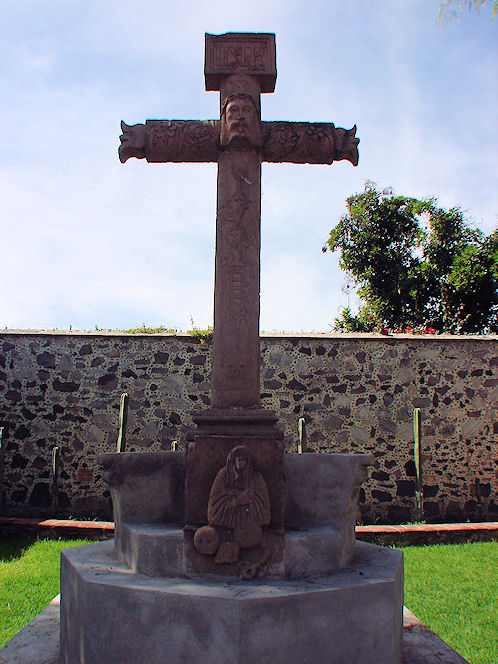

"Acolman Convent" Cross
Across The Street From Front Gate Entrance
"Acolman Convent" or "Monastery of San Agustín,"
Acolman Municipality, Near Teotihuacán México. Face Of Jesus Christ.
Across The Street From Front Gate Entrance
"Acolman Convent" Cross
"Acolman Convent" or "Monastery of San Agustín,"
Acolman Municipality, Near Teotihuacán México. 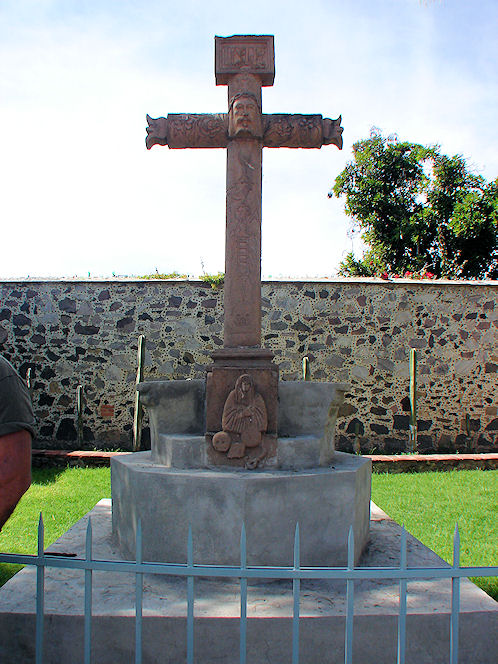
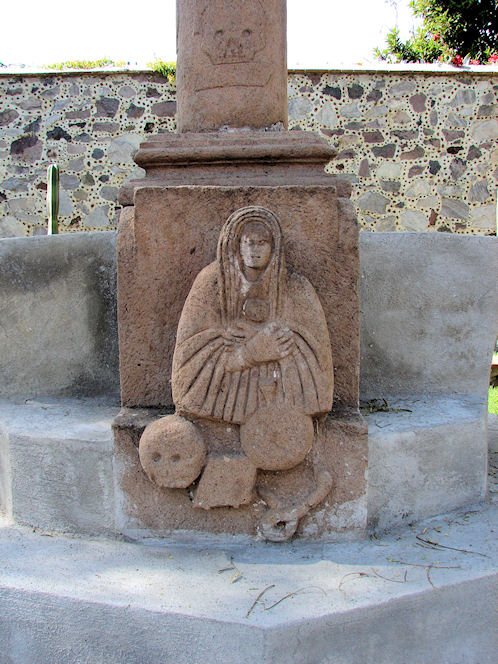
"Acolman Convent" Cross
Across The Street From Front Gate Entrance
"Acolman Convent" or "Monastery of San Agustín,"
Acolman Municipality, Near Teotihuacán México. "Virgin of Sorrows" or "Goddess Coatlicue".
Across The Street From Front Gate Entrance
"Acolman Convent" Cross
"Acolman Convent" or "Monastery of San Agustín,"
Acolman Municipality, Near Teotihuacán México. 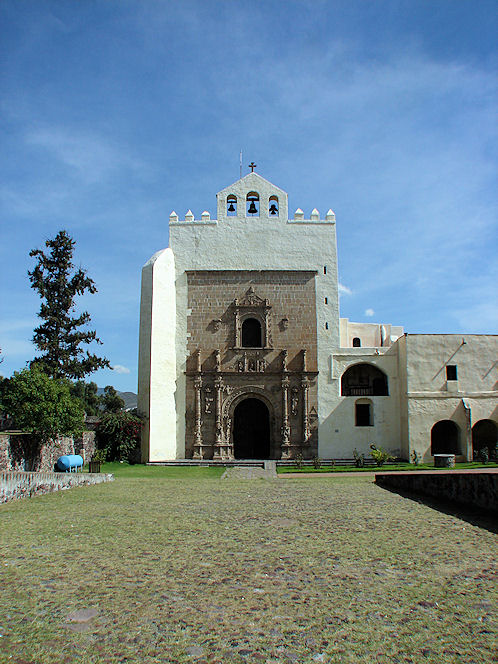

Facade.
"Acolman Convent" or "Monastery of San Agustín,"
Acolman Municipality, Near Teotihuacán México. Facade.
"Acolman Convent" or "Monastery of San Agustín,"
Acolman Municipality, Near Teotihuacán México. 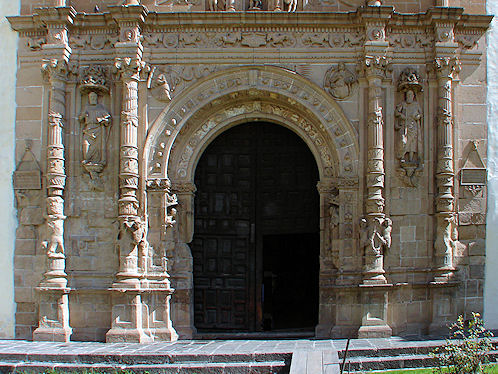
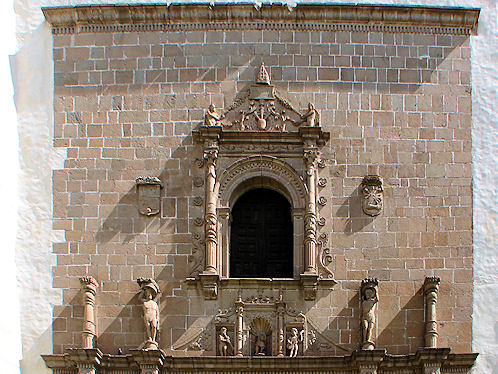
Lower Facade.
"Acolman Convent" or "Monastery of San Agustín,"
Acolman Municipality, Near Teotihuacán México. Upper Facade.
"Acolman Convent" or "Monastery of San Agustín,"
Acolman Municipality, Near Teotihuacán México. 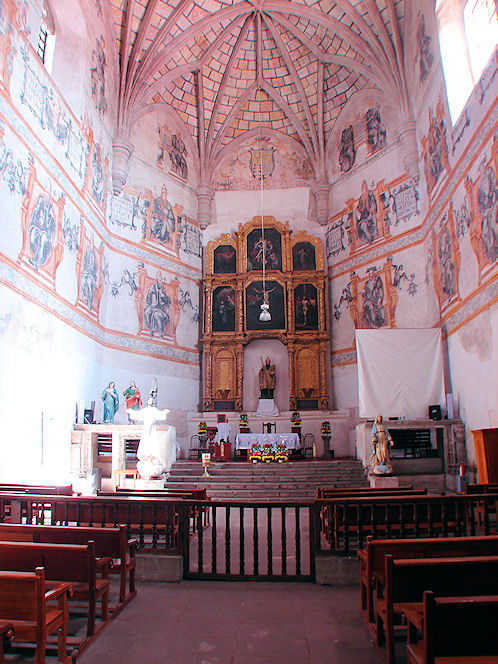
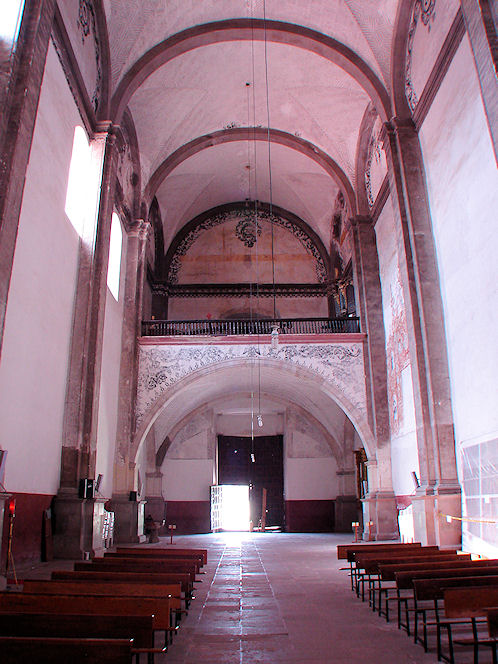
Altar.
"Acolman Convent" or "Monastery of San Agustín,"
Acolman Municipality, Near Teotihuacán México. Rear Entrance To Chapel.
"Acolman Convent" or "Monastery of San Agustín,"
Acolman Municipality, Near Teotihuacán México. 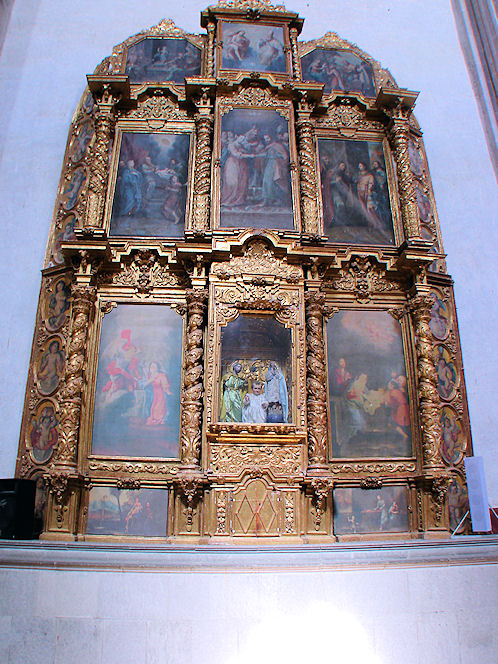
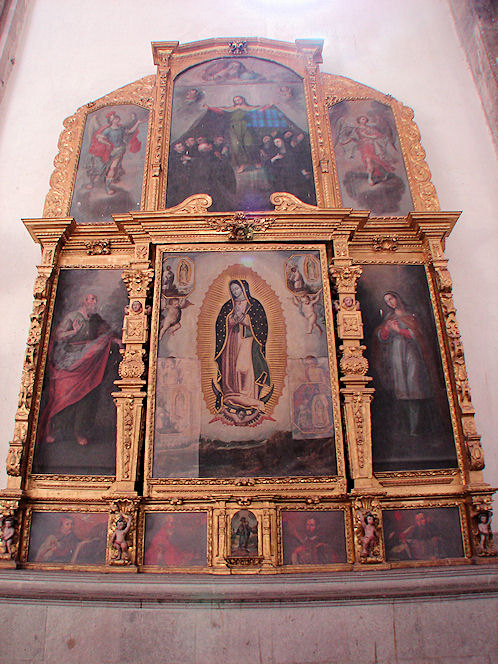
Left Chapel Wall.
"Acolman Convent" or "Monastery of San Agustín,"
Acolman Municipality, Near Teotihuacán México. Right Chapel Wall.
"Acolman Convent" or "Monastery of San Agustín,"
Acolman Municipality, Near Teotihuacán México. 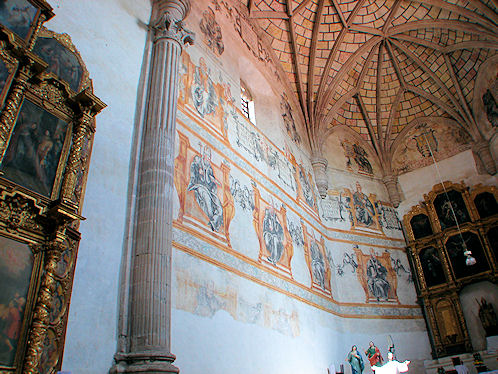

Left Altar Wall.
"Acolman Convent" or "Monastery of San Agustín,"
Acolman Municipality, Near Teotihuacán México. Right Altar Wall.
"Acolman Convent" or "Monastery of San Agustín,"
Acolman Municipality, Near Teotihuacán México. 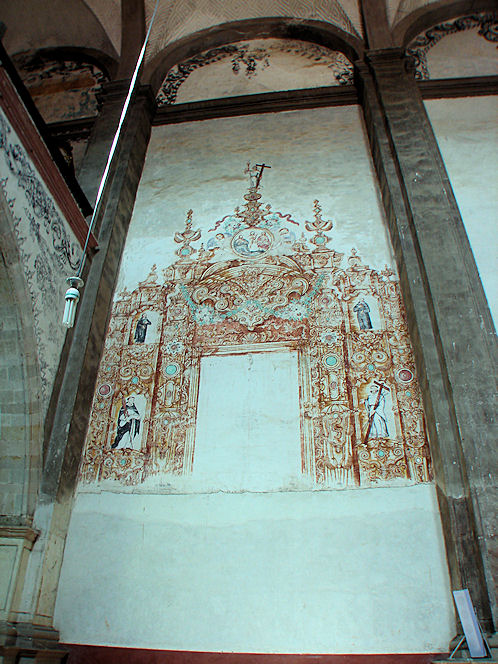
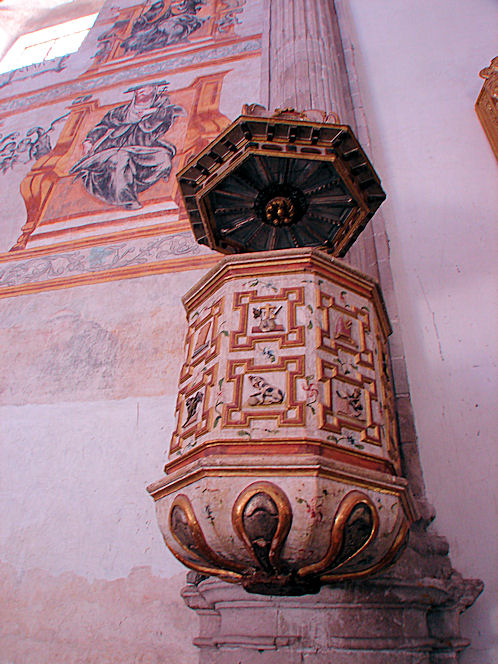
"Left Chapel Wall Design.
Acolman Convent" or "Monastery of San Agustín,"
Acolman Municipality, Near Teotihuacán México. Pulpit
"Acolman Convent" or "Monastery of San Agustín,"
Acolman Municipality, Near Teotihuacán México. 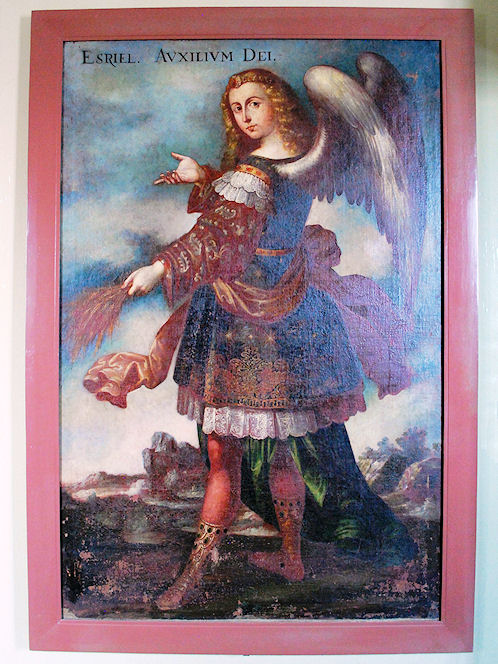
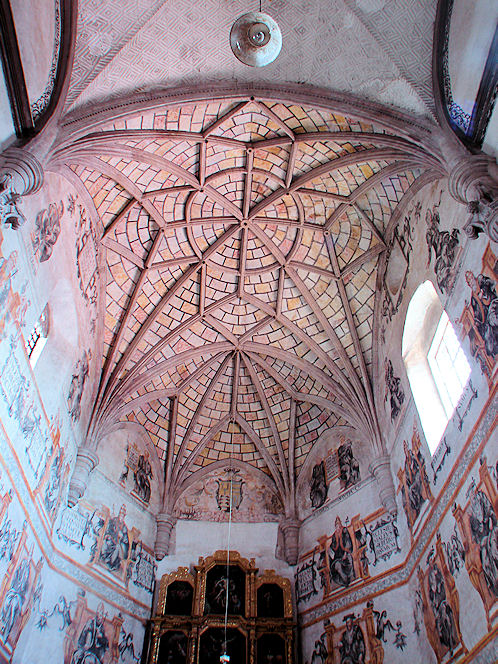
"Angel de la Letania"
Painted By Unknown Artist.
"Acolman Convent," or "Monastery of San Agustín,"
Acolman Municipality, Near Teotihuacán México. Ceiling.
"Acolman Convent" or "Monastery of San Agustín,"
Acolman Municipality, Near Teotihuacán México.

We Are Proud Of Our SafeSurf Rating!
Click On Any Of The Following Links By Amazon.Com
For Gold Rosaries. No Obligation!
Click Here To See The Nearby Ancient City Of Teotihuacán
Back To Mexico City Tours Main Page
Back To Mexico Trips Main Page
Back To DeLange Home Page
We wish to thank Wikipedia, the free encyclopedia for some of the information on this page. We share information with Wikipedia. The "Monastery of San Agustín," or "Acolman Convent," is located about ten kms (6 miles) from Teotihuacán and was converted into a museum. It is open from 10 AM - 5 PM - Tue -Sat. Admission is $37 (Pesos). During the Colonial-period of many countries in Latin America, the construction of open-air chapels were designed for outdoor worship. This is because the native people were accustomed to the open-air rituals of their religion. Therefore, the atrium—a large, walled and gated yard was built in front of the monastery—and various types of open-air chapels were designed for outdoor worship. In Mexico the missionary friars directed the transformation of outdoor walled temple precincts into monastery atriums and replaced open-air indigenous ceremonies with outdoor Christian worship. Similarly, open chapels were built intentionally to recall the native teocalli, or open-air temples. Stylistically, too, these Mexican monasteries reveal a hybrid cultural legacy, combining indigenous and European traits to create a distinctive “Indo-Christian” style. There are three significant sixteenth-century monasteries, one each, located in Huejotzingo, Coixtlahuaca, and Acolman, built under the Franciscans, the Dominicans, and the Augustinians, respectively, demonstrating the new colonial style. There are other places of worship in Mexico which also reflect this same style. Almost always, these churches were built upon the current temples of the native people. At Acolman the single-nave fortress church appears to have been built on a pre-Hispanic base and incorporates stones from a temple dedicated to Quetzalcoatl; the indigenous temple yard may have been transformed into the atrium. Acolman is best known for its church façade, a unique example of Spanish Plateresque style in Mexico. Plateresque (from plateresco) employs silverwork designs in an ornate, whimsical, yet intellectual Renaissance style. Plateresque monuments, which rework Classical prototypes in a humorous, sophisticated way, are the antithesis of sober Dominican architecture, and they contrast dramatically with Franciscan simplicity. Thus, the basic components of the Acolman façade—a single arched opening flanked by paired columns—are transformed into a triumphal arch with paired garlanded candelabra. Carved fruits, breads, seahorses, and other unexpected objects ornament the arch's voussoirs (wedge-shaped stones). In the third level, a sculpted indigenous toponym, or place name, in the form of an arm dripping water, signifies “Acolman.” Declared a national monument by México, in 1933, the monastery of San Agustín was built between 1539 and 1580 with most of the work being done after 1550. The walls are of rubble-stone construction and covered in plaster, topped by battlements, and the overall appearance is that of fortress. The crown of battlements, the single bell tower, the open chapel and the Plateresque facade identify the complex as a classic 16th century religious construction. The fortress appearance of complexes of this time were not literally for protection but rather served to dominate the landscape much as mediaeval castles in Europe did. In areas where there are carefully fitted stones, these stones have been carved. The construction of the monastery is attributed to Andrés de Olmos. Restoration work has been done in this complex since the 1920s, which has revealed all of the church’s facade and the atrium is terraced down to its original level of construction. This has exposed the flood damage from the colonial period. Most of the murals and frescos had been buried under years of plaster and paints before being restored. The complex is fronted by a large square atrium, and a courtyard before that, the two of which are today separated by a road. The most important feature of this atrium area is the 7 ft 10 in high stone cross, which is considered to be an important expression of "tequitqui" or Christian art executed by Indian craftsmen from the very early colonial period. The cross was mostly likely erected between the time that the Franciscans occupied the site and before the architectural sculptures of the current complex. The cross is decorated with plants, flowers and flames at the top (which allude to the Passion of Christ) all sculpted into the stone. There is also a melancholy, mask-like face of Christ, with crown of thorns which projects from the center of the cross. At the foot of the stone cross is a Madonna figures who has been identified as the Virgin of Sorrows and even associated with the goddess Coatlicue. At the feet of this Virgin is a weathered stone skull and a serpent, an in her breast is imbedded a dark stone disk. This follows the Aztec tradition of placing jades or other precious stones in their statues to symbolize the soul. To the back of the atrium area is the main church, with its rose/tan Plateresque facade reminiscent of the Colegiata de Santa María in Calatayud, Spain. The facade has Classical composite columns with Plateresque sections below the ribbon garniture, Saint Paul under a deep, Gothic-like canopy with a Renaissance angel below. The portal has double Renaisaance doors under archivaults decorated with fruit. Above the doors are seahorses on the main frieze and Moorish paneling on the doors themselves. This facade was mostly likely created by Spanish craftsmen and had significant influence on other Augustinian church fronts in New Spain, especial at Yuriria and Cuitzeo in Michaocán and at Metztitlán in Hidalgo. The church building is 205 ft long, 56 ft wide and 70 ft high, with the interior walls particularly high. The interior vault was modified and the interior pilasters and exterior buttresses were added in 1735. The main altarpiece dates from 1690 and was put here in the 20th century to replace the original. The side altarpieces date from the 18th century. These Baroque altarpieces are all sculpted in wood and gilded, decorated with plants, flower, celetial figures and angels. The presbetry has a late medieval ribbed vault and important frescos in black, white and orange, with images of saints on thrones, priests and Augustine popes. The small open chapel, or chapel of the Indians is located on the upper part of the wall between the church and the main portal to the cloister area. This chapel contains two murals from the 16th century by unknown authors depicting the Last Judgement and Catherine of Alexandria. The church is flanked by two cloisters: the older Franciscan cloister in the front, and the Augustinian friary in the rear. The Claustro Chico or small cloister is of simple architecture, constructed in stone with a cross in the center which has an anagram of Jesus' name. The Claustro Grande or large cloister (also called the Naranjo or Orange Tree cloister) has a more elaborate Plateresque design with "Isabelino" type columns. The small cloister may date from the Franciscan period or might be part of the early Augustinian church. Flatted arches on piers with a barrel-vaulted corridor on the ground level and a wood-roofed second level suggest the simple construction of the very early colonial period. Primitive frescos decorate the walls. The stone cross here is very similar to the Franciscan cross at one of the earliest monasteries in Cuernavaca. The crucifixion fresco on the second level is inspired by various European sources of the 15th and 16th centuries such as German prints, Italian and German ornamental panels. Starkly done in black and white, it reflects the continuing importance of the graphic arts. It also has sun and moon designs, common during the early colonial period, which reflect both old European astrological symbols as well as the importance of these in native art. In the larger, more ornate, cloister, there are medallions with images such as the coat of arms of the Augustine order, a symbol for death, and a symbol representing the union of two worlds. The lower floor has a series of stone etchings with scenes related to the Passion of Christ. The Augustinian friary in the rear has Indo-Christian traits. In the bottom arcade, Indian figures with speech glyphs appear; the upper arcade capitals are carved with feathers and Aztec fret designs. The elevated open-air balcony chapel, built during the initial Franciscan phase, is situated above the portico chapel, next to the church. Overlooking the atrium, this chapel served as an elevated balcony from which the friars preached to the neophytes below. Such elevated open chapels were common in the initial decades of colonization, and the colonizers built many on top of pyramids. European precedents are difficult to find, suggesting pre-Columbian inspiration.
Museo Virrenal: Much of the cloister area is occupied by the "Museo Virrenal" (Colonial Era) founded in 1925 in what were the portico, the kitchen the refectory and the hallway to the refectory. It has three main halls which give a detailed explanation of the construction of the site, the lives of the monks and the collection of paintings and religious objects that are on display. The museum contains more than 120 pieces. Many of the religious artwork and objects are in the third hall and include furniture, cloaks, and other religious garb (some embroidered in gold thread), sculptures in stone, wood and corn stalk paste, and oils from the 16th to the 19th centuries. As municipal seat, the town of Acolman is the governing authority for over sixty other named communities,(inegi) which cover a total area of 86.88 km2. At the 2010 census, the total population of the municipality was 136,558, but only about four percent of this population lives in the town proper.(inegi) The municipality borders the municipalities of Tecámac, San Juan Teotihuacán, San Salvador Atenco, Tezoyuca, Chiautla, Tepetlaoxtoc and Ecatepec.
|
The Mexico City International Airport (Spanish: Aeropuerto Internacional de la Ciudad de México or AICM), also called Benito Juárez International Airport (IATA: MEX, ICAO: MMMX) is the major commercial airport that serves Mexico City, the capital of Mexico. It is also Mexico's and Latin America's busiest airport! We would suggest using this airport if you wish to visit Acolman Convent. We also would suggest visiting Acolman Convent as a short side trip, when you are visiting Teotihuacán. It is not that far out of your way!
There are many very good hotels and motels in the area, and if you need a place to stay; Priceline.com can arrange that for you. In fact, we think they are the best way to do it! We have personally, booked flights, hotels, and vacations, through Priceline.com and we can highly recommend them. Their website is very easy to use! We have some links to Priceline.com on this page, since they can arrange all of your air flights, hotels and car. We of course, appreciate your use of the advertising on our pages, since it helps us to keep our pages active. We also have links on this page, that will connect you with several of the best hotels in Mexico City. Hotels that we have personally used! We could, also suggest getting a hotel, and then letting them arrange for either a car, or a tour of Mexico City. If you call their Concierge Services, ahead of your arrival, all of this can be pre-arranged for you. We have used this method, many times, when traveling in Mexico. We have found it to be safe and it works!!! We have never experienced a problem, doing it this way!
|
 |
| Front Gate Entrance. "Acolman Convent" or "Monastery of San Agustín," Acolman Municipality, Near Teotihuacán México. |
|---|
 |
| Altar Area. "Acolman Convent" or "Monastery of San Agustín," Acolman Municipality, Near Teotihuacán México. |
Click On Any Of The Following Links By Amazon.Com
For Rosaries. No Obligation!


"Acolman Convent" Cross
Across The Street From Front Gate Entrance
"Acolman Convent" or "Monastery of San Agustín,"
Acolman Municipality, Near Teotihuacán México. Face Of Jesus Christ.
Across The Street From Front Gate Entrance
"Acolman Convent" Cross
"Acolman Convent" or "Monastery of San Agustín,"
Acolman Municipality, Near Teotihuacán México. 

"Acolman Convent" Cross
Across The Street From Front Gate Entrance
"Acolman Convent" or "Monastery of San Agustín,"
Acolman Municipality, Near Teotihuacán México. "Virgin of Sorrows" or "Goddess Coatlicue".
Across The Street From Front Gate Entrance
"Acolman Convent" Cross
"Acolman Convent" or "Monastery of San Agustín,"
Acolman Municipality, Near Teotihuacán México. 

Facade.
"Acolman Convent" or "Monastery of San Agustín,"
Acolman Municipality, Near Teotihuacán México. Facade.
"Acolman Convent" or "Monastery of San Agustín,"
Acolman Municipality, Near Teotihuacán México. 

Lower Facade.
"Acolman Convent" or "Monastery of San Agustín,"
Acolman Municipality, Near Teotihuacán México. Upper Facade.
"Acolman Convent" or "Monastery of San Agustín,"
Acolman Municipality, Near Teotihuacán México. 

Altar.
"Acolman Convent" or "Monastery of San Agustín,"
Acolman Municipality, Near Teotihuacán México. Rear Entrance To Chapel.
"Acolman Convent" or "Monastery of San Agustín,"
Acolman Municipality, Near Teotihuacán México. 

Left Chapel Wall.
"Acolman Convent" or "Monastery of San Agustín,"
Acolman Municipality, Near Teotihuacán México. Right Chapel Wall.
"Acolman Convent" or "Monastery of San Agustín,"
Acolman Municipality, Near Teotihuacán México. 

Left Altar Wall.
"Acolman Convent" or "Monastery of San Agustín,"
Acolman Municipality, Near Teotihuacán México. Right Altar Wall.
"Acolman Convent" or "Monastery of San Agustín,"
Acolman Municipality, Near Teotihuacán México. 

"Left Chapel Wall Design.
Acolman Convent" or "Monastery of San Agustín,"
Acolman Municipality, Near Teotihuacán México. Pulpit
"Acolman Convent" or "Monastery of San Agustín,"
Acolman Municipality, Near Teotihuacán México. 

"Angel de la Letania"
Painted By Unknown Artist.
"Acolman Convent," or "Monastery of San Agustín,"
Acolman Municipality, Near Teotihuacán México. Ceiling.
"Acolman Convent" or "Monastery of San Agustín,"
Acolman Municipality, Near Teotihuacán México.

We Are Proud Of Our SafeSurf Rating!
Click On Any Of The Following Links By Amazon.Com
For Gold Rosaries. No Obligation!
Click Here To See The Nearby Ancient City Of Teotihuacán
Back To Mexico City Tours Main Page
Back To Mexico Trips Main Page
Back To DeLange Home Page
 |  |
| "Acolman Convent" Cross Across The Street From Front Gate Entrance "Acolman Convent" or "Monastery of San Agustín," Acolman Municipality, Near Teotihuacán México. | Face Of Jesus Christ. Across The Street From Front Gate Entrance "Acolman Convent" Cross "Acolman Convent" or "Monastery of San Agustín," Acolman Municipality, Near Teotihuacán México. |
|---|---|
 |  |
| "Acolman Convent" Cross Across The Street From Front Gate Entrance "Acolman Convent" or "Monastery of San Agustín," Acolman Municipality, Near Teotihuacán México. | "Virgin of Sorrows" or "Goddess Coatlicue". Across The Street From Front Gate Entrance "Acolman Convent" Cross "Acolman Convent" or "Monastery of San Agustín," Acolman Municipality, Near Teotihuacán México. |
 |  |
| Facade. "Acolman Convent" or "Monastery of San Agustín," Acolman Municipality, Near Teotihuacán México. | Facade. "Acolman Convent" or "Monastery of San Agustín," Acolman Municipality, Near Teotihuacán México. |
 |  |
| Lower Facade. "Acolman Convent" or "Monastery of San Agustín," Acolman Municipality, Near Teotihuacán México. | Upper Facade. "Acolman Convent" or "Monastery of San Agustín," Acolman Municipality, Near Teotihuacán México. |
 |  |
| Altar. "Acolman Convent" or "Monastery of San Agustín," Acolman Municipality, Near Teotihuacán México. | Rear Entrance To Chapel. "Acolman Convent" or "Monastery of San Agustín," Acolman Municipality, Near Teotihuacán México. |
 |  |
| Left Chapel Wall. "Acolman Convent" or "Monastery of San Agustín," Acolman Municipality, Near Teotihuacán México. | Right Chapel Wall. "Acolman Convent" or "Monastery of San Agustín," Acolman Municipality, Near Teotihuacán México. |
 |  |
| Left Altar Wall. "Acolman Convent" or "Monastery of San Agustín," Acolman Municipality, Near Teotihuacán México. | Right Altar Wall. "Acolman Convent" or "Monastery of San Agustín," Acolman Municipality, Near Teotihuacán México. |
 |  |
| "Left Chapel Wall Design. Acolman Convent" or "Monastery of San Agustín," Acolman Municipality, Near Teotihuacán México. | Pulpit "Acolman Convent" or "Monastery of San Agustín," Acolman Municipality, Near Teotihuacán México. |
 |  |
| "Angel de la Letania" Painted By Unknown Artist. "Acolman Convent," or "Monastery of San Agustín," Acolman Municipality, Near Teotihuacán México. | Ceiling. "Acolman Convent" or "Monastery of San Agustín," Acolman Municipality, Near Teotihuacán México. |

We Are Proud Of Our SafeSurf Rating!
Click On Any Of The Following Links By Amazon.Com
For Gold Rosaries. No Obligation!
|
|
|---|
Click Here To See The Nearby Ancient City Of Teotihuacán
|
Back To Mexico City Tours Main Page
|
Back To Mexico Trips Main Page
|
Back To DeLange Home Page |




